Chinese Shar-Pei
Adobe Stock/Eliška
The Shar-Pei originated in China during the Han Dynasty over 2,000 years ago.
This breed is well known for their broad muzzle, bluish-black tongue, tiny eyes and ears, and folds of skin on their face, neck, and shoulders. As a medium-sized breed, Shar-Pei dogs weigh 45–60 pounds and stand about 18–20 inches at the shoulder.
Chinese farmers initially used Shar-Pei to guard and herd their livestock. By the 1900s, Shar-Pei were also used for hunting boar and guarding the home.
Today, Chinese Shar-Pei are loyal companions but, like all other breeds, they need consistent training to learn good behavior around new people, other pets, and children.
Caring for a Chinese Shar-Pei
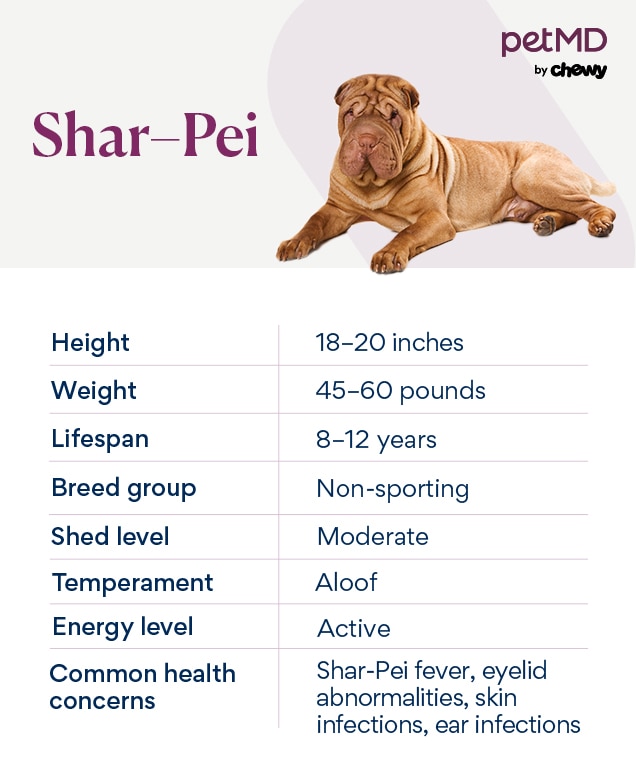
Shar-Pei dogs can make great companions, but they might be a challenge for first-time pet parents. This is because, while Chinese Shar-Pei are smart dogs, they can be willful.
They can also develop anxiety without proper socialization, especially when meeting new people or in new situations. Pet parents must dedicate themselves to training when bringing home a Chinese Shar-Pei puppy—otherwise, their pup might develop unwanted behaviors that arise from anxiety and fear.
Shar-Pei are laid-back dogs that don’t require as much exercise as some other dog breeds. They enjoy going on short walks and are happy in an apartment or small home.
They are affectionate dogs around caregivers, but Shar-Pei might be slow to warm up to strangers. Supervised introductions to other pets and children at a young age are important so Shar-Pei learn that new people and animals aren’t scary.
Chinese Shar-Pei Health Issues
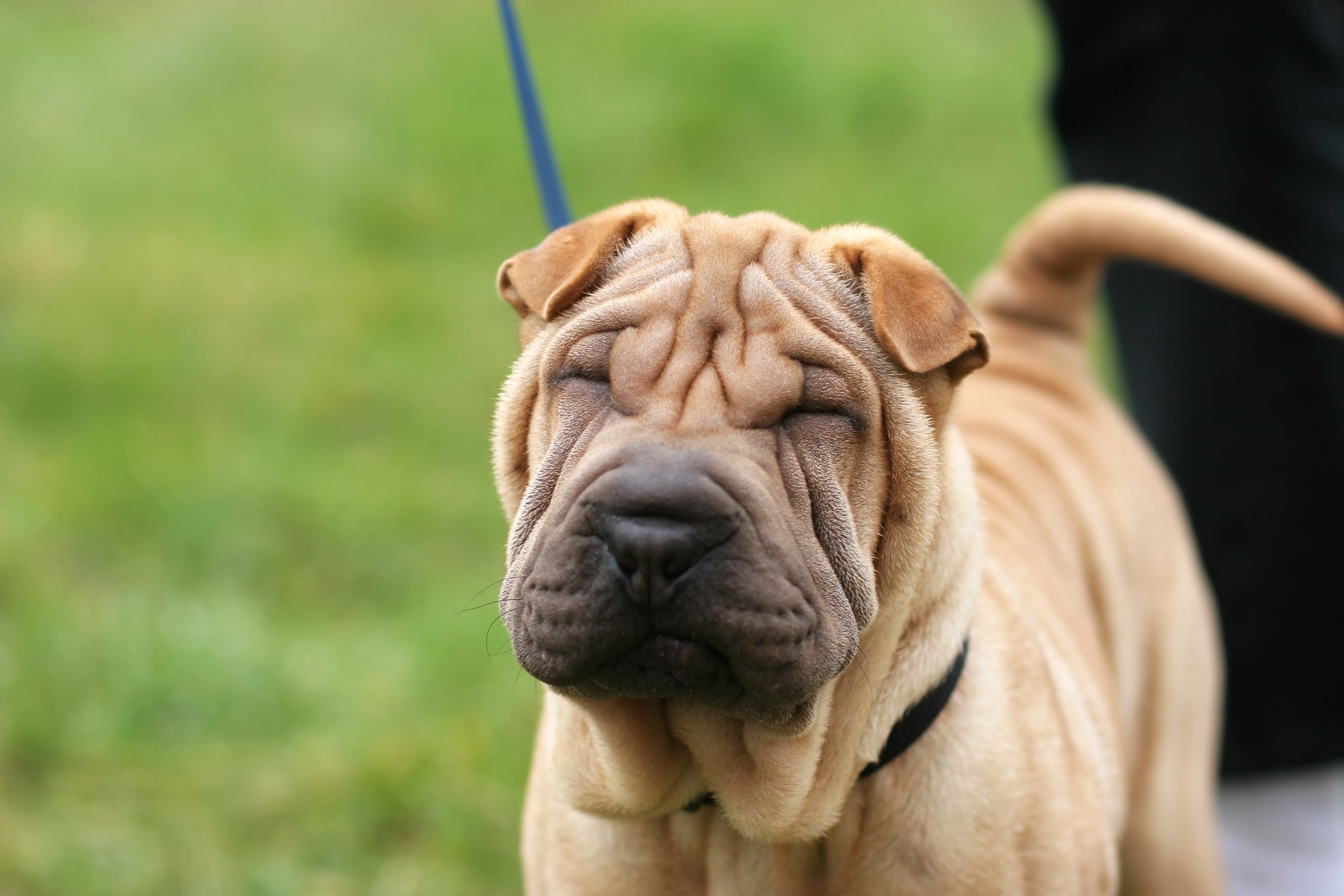
The average Chinese Shar-Pei lifespan is 8–12 years. Before bringing home a Shar-Pei puppy, know that there are some health concerns this breed may develop.
Entropion
The wrinkles on a Shar-Pei’s face are cute, but they can cause the eyelids to roll toward the eye—a condition called entropion.
When this happens, the eyelashes and eyelids rub against the surface of the eye (the cornea). This is a very painful condition that can lead to corneal ulcers.
Entropion is usually diagnosed when a Shar-Pei puppy is under 1 year old. It’s corrected with surgery.
Shar-Pei Fever
Shar-Pei fever, also known as swollen hock syndrome, is a hereditary condition caused by a genetic mutation that’s more common in dogs with excessive skin folds. Symptoms include:
-
High fever (ranging from 103–107 F)
-
Ankle swelling
Shar-Pei fever can ultimately lead to kidney failure, and treatment isn’t usually effective because of how quickly the condition progresses.
This is an inherited condition, so Shar-Pei dogs can be tested to see if they carry the gene. Shar-Pei that have this genetic mutation should not be bred.
Skin Fold Dermatitis
A Shar-Pei’s skin folds are breeding grounds for bacteria and yeast. These skin folds trap moisture, leading to skin infections.
When caring for a Shar-Pei, it’s important to inspect these folds once or twice a week. If the skin between the folds becomes moist, red, crusty, black, or has an odor, then a skin infection is likely present—you’ll need to take your dog to your veterinarian.
The vet may prescribe medicated wipes and/or medicated shampoo to keep the skin between these folds clean and free of infection.
Pododermatitis
Chinese Shar-Pei dogs are also prone to inflammation and infection on the skin between their toes, called pododermatitis. This may be due to a problem with their hair follicles, or it could be due to allergies, to a skin mite called demodex, or to hypothyroidism.
Shar-Pei with pododermatitis lick their feet excessively because of their itchy skin. This constant licking causes the skin between the toes to become red, moist, and prone to bacterial and yeast infections.
Check your Shar-Pei’s feet if you notice excessive licking, and schedule an appointment with your veterinarian if the skin appears infected. Until the vet appointment, a recovery cone can prevent any further toe-licking.
Ear Infections
Shar-Pei are prone to ear infections because this breed has very narrow ear canals that trap moisture, which creates a prime environment for yeast and bacteria to thrive.
To minimize the risk of an infection, clean your Shar-Pei’s ears with a routine ear cleaner that contains a drying agent every one to two weeks for maintenance.
Make ear cleaning a part of your regular routine when you first bring home your Shar-Pei puppy so that they get used to the process.
What To Feed a Chinese Shar-Pei
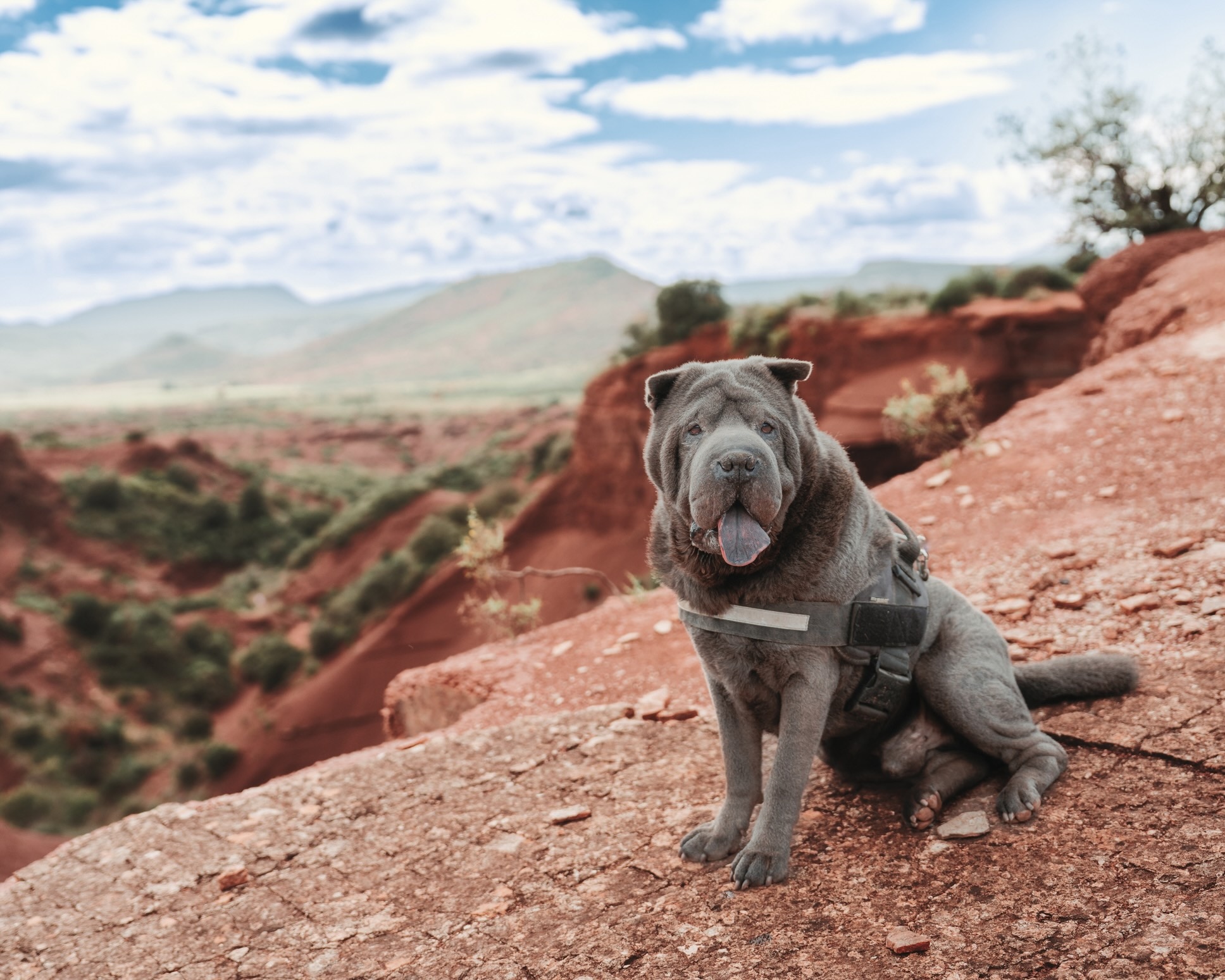
During their first 12 months of life, a Shar-Pei puppy should be fed a medium-breed, high-quality puppy formula that’s high in calories to allow for proper growth.
When your puppy turns 1, slowly transition their diet to an adult medium-breed dog formula. At 7 years of age, your Shar-Pei can begin a senior diet that contains joint support.
Talk to your vet about the best food for your dog. Along with being formulated for your Shar-Pei’s life stage, their food must meet the nutritional standards set by the Association of American Feed Control Officials (AAFCO).
How To Feed a Chinese Shar-Pei
Shar-Pei dogs should be fed two meals a day, one in the morning and one in the evening. If your Shar-Pei eats too quickly, buy a slow feeder bowl to slow them down at mealtime.
How Much Should You Feed a Chinese Shar-Pei?
Follow the feeding guidelines on your dog food packaging. You should also consult your veterinarian to determine the proper portion size to feed your Shar-Pei, as how much to feed your dog is based on many different factors.
Always measure out the food for each meal to ensure you’re feeding your pup the right amount. Your Shar-Pei’s daily diet should consist mostly of dog food (90%), with only 10% or less being treats.
Nutritional Tips for a Chinese Shar-Pei
Because Shar-Pei are prone to skin issues, an omega-3 fatty acid supplement can help support the skin barrier, prevent dandruff, and minimize secondary skin infections. Omega-3 fatty acid supplements also reduce inflammation in the joints.
Always talk to your vet before giving your dog a supplement.
Behavior and Training Tips for a Chinese Shar-Pei
Chinese Shar-Pei Personality and Temperament
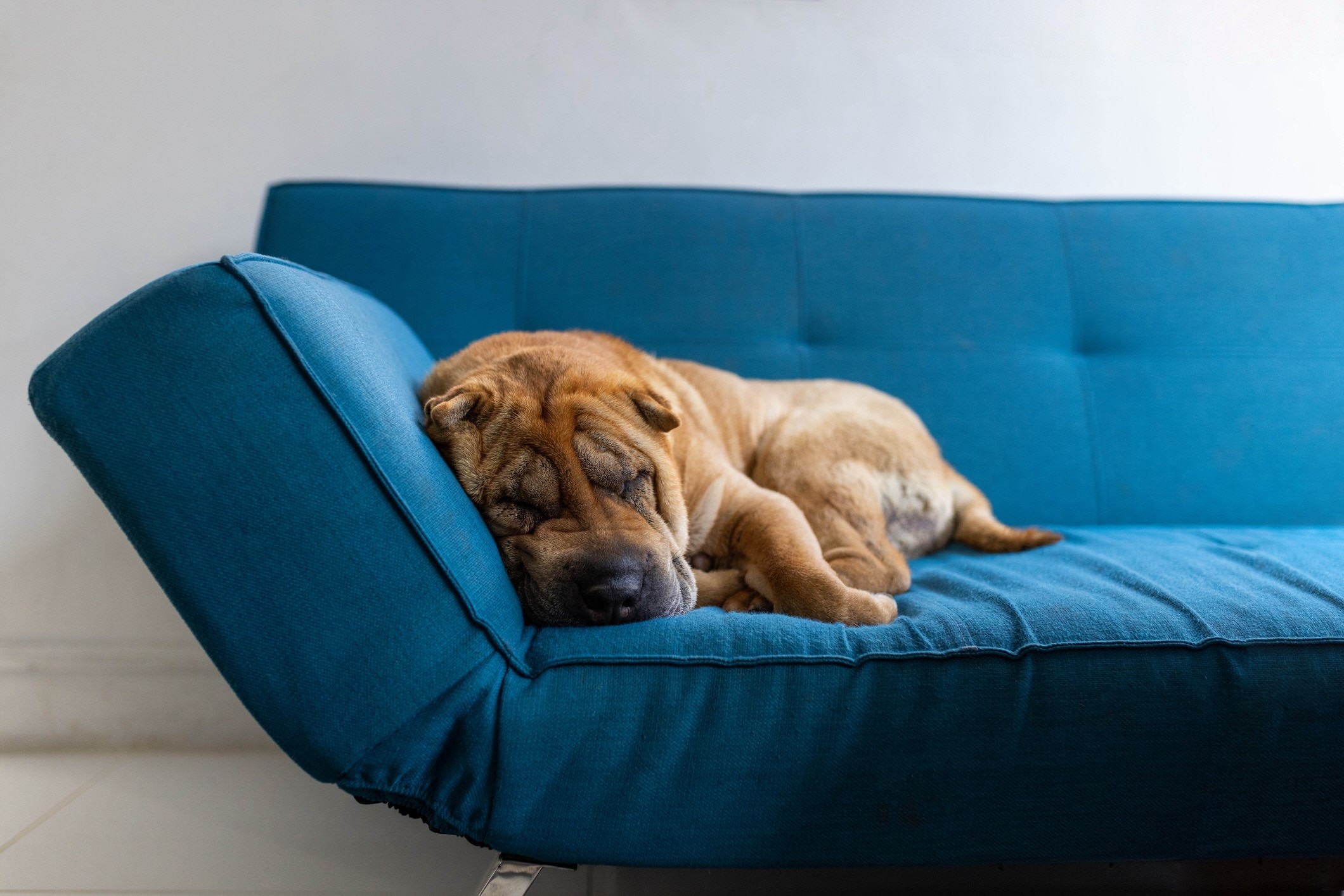
Shar-Pei can have a kind temperament toward those they know, but they’re sometimes standoffish to strangers. Socialization needs to be a priority when a Shar-Pei puppy is 8–12 weeks old; this will help get them used to children, other pets, and new people.
Shar-Pei dogs don’t need a ton of exercise, but they do enjoy going on daily short walks or having 30 minutes set aside per day for exercise, like agility.
Shar-Pei have a moderate to high prey drive, thanks to their history as hunting dogs. If they aren’t introduced to cats and other small animals when they’re young, they may chase or try to herd them (as Shar-Pei used to herd livestock thousands of years ago in China).
It’s important to keep your dog on a leash or inside a fenced-in space whenever you’re outside.
Chinese Shar-Pei Behavior
Because a Shar-Pei’s personality is naturally a bit anxious, new situations can be stressful for them. Give your Shar-Pei positive reinforcement and introduce them to new people, animals, and environments at a pace they feel comfortable with.
This breed can be fearful around other pets and people, so obedience training classes are important to help Shar-Pei puppies learn to be comfortable, calm, and well behaved.
Shar-Pei are also known to bark when they feel threatened or anxious. Again, socialization and obedience training can help reduce this behavior.
Chinese Shar-Pei Training
Shar-Pei dogs are smart, but they can be strong-willed and do best with pet parents who have experience training dogs.
Start training your pup when they’re young, and give them positive rewards through praise and treats to teach them how to behave politely. Teaching Shar-Pei basic cues, such as “sit,” “stay,” and “come,” is very important.
Ideally, a Shar-Pei should take both socialization and obedience training classes with a professional certified dog trainer.
Fun Activities for a Chinese Shar-Pei
-
Obedience
-
Agility
-
Tracking
-
Neighborhood walks
-
Lounging at home
Chinese Shar-Pei Grooming Guide
A Shar-Pei’s coat doesn’t need much grooming, but their wrinkly skin requires special care.
Skin Care
Shar-Pei are known for their wrinkles, which can be all over their body. These wrinkles can trap moisture, leading to skin infections.
Check your Shar-Pei’s skin at least twice a week to monitor for signs of infection. If your dog’s skin becomes red or black, experiences hair loss, or has an odor, take your Shar-Pei to the vet.
If your Chinese Shar-Pei has a lot of skin folds (some dogs are more wrinkly than others) that tend to get infected, talk to your vet. They may recommend bathing your dog with a medicated antibacterial/antifungal shampoo every week or two to help keep your dog’s skin healthy.
Coat Care
A Shar-Pei’s coat is short and not prone to tangles or mats, but it’s important to brush your dog once a week to minimize shedding. Soft bristle brushes and rubber grooming mitts are good tools to use.
Eye Care
Because Shar-Pei dogs can develop entropion, monitor your dog’s eyes for signs of this health condition. Common symptoms include:
-
Squinting
-
Holding the eye shut
Talk to your vet if you notice changes in your Chinese Shar-Pei’s eyes.
Ear Care
Because a Shar-Pei’s ears are small and have narrowed ear canals, they may need to be cleaned on a regular basis and after your pup is in water (like bathing or swimming).
Nail Care
Trim your Shar-Pei’s nails every four to eight weeks. When you hear their nails clicking against the floor, it’s time to trim.
Considerations for Pet Parents
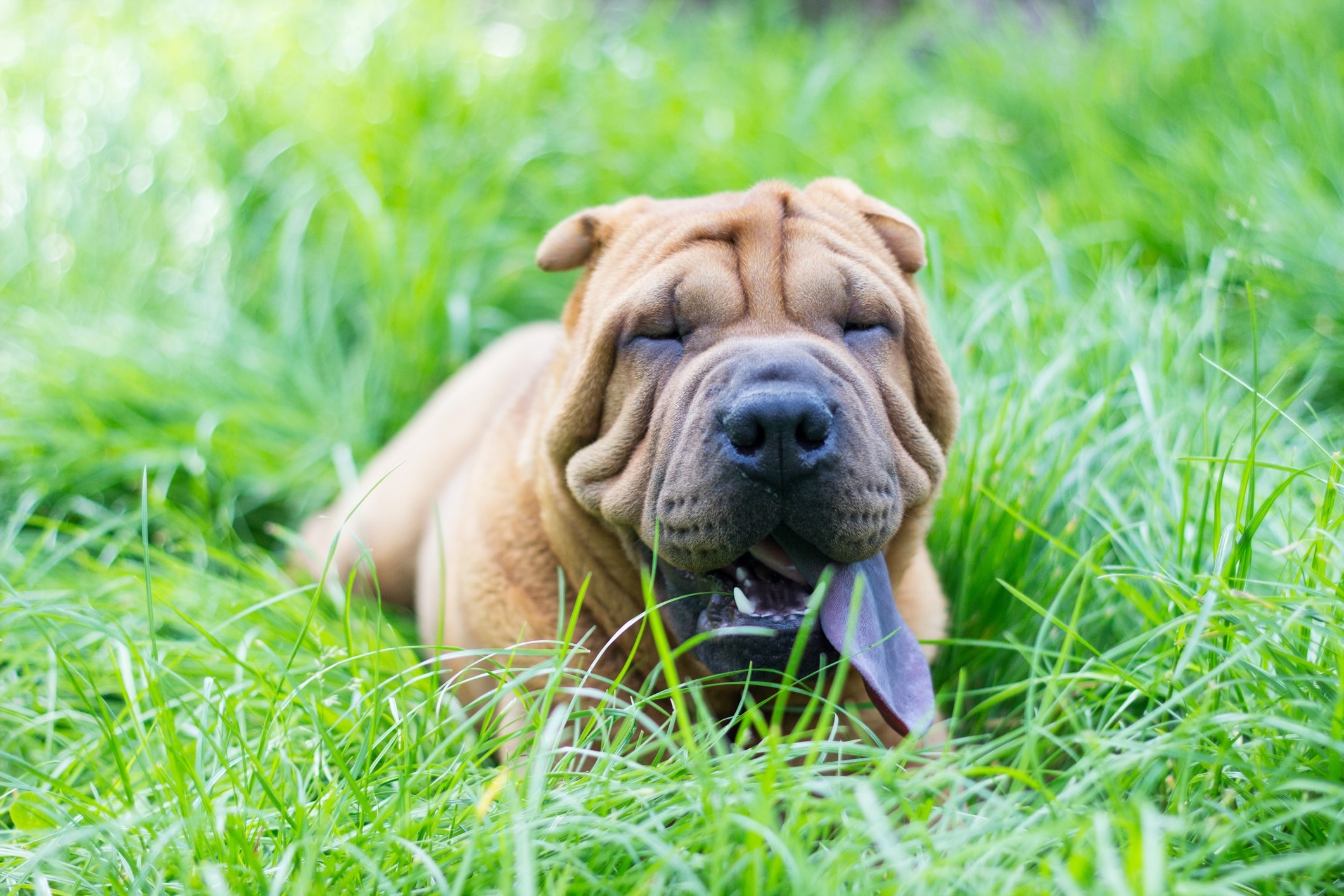
Shar-Pei can make great companions, but they need a lot of training initially to help prevent them from being anxious. This breed is not recommended for first-time pet parents.
Shar-Pei dogs need a family that will be dedicated to training them, cleaning their ears weekly, and monitoring the skin folds on their body for signs of infection. Purchasing pet insurance for a newly adopted Shar-Pei is recommended.
The perfect home for an 8- to 12-week-old Shar-Pei puppy would be a home with older children and, perhaps, no other pets.
Chinese Shar-Pei FAQs
Is a Chinese Shar-Pei a good family dog?
A Shar-Pei can make a good family dog for the right family. They do best with older children and might prefer to be the only pet in the home unless they’re properly introduced to other animals at a young age.
Are Chinese Shar-Pei smart dogs?
Yes, Shar-Pei are smart dogs. But they can be strong-willed, so enrolling them in training classes with a professional can be helpful.
What do Chinese Shar-Pei dogs do when they are bored?
Shar-Pei are a calm and low-energy breed. They are not ones to be destructive or mischievous if they don’t get lots of attention, but they can become anxious and bark.
Does a Chinese Shar-Pei need a lot of exercise?
Shar-Pei do not require much exercise daily and do well living in an apartment—just a few short walks a day (about 30 minutes total) will make this breed happy.
How much does a Chinese Shar-Pei cost?
The average Chinese Shar-Pei price varies by where you live, breeder, and bloodlines, but you can expect to pay at least $1,000.
